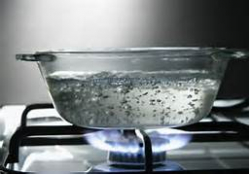Water Boil Warning Information
If You Receive a Boil Water Notice:
What happened?
Usually, boil water notices are issued when an event causes the water system to lose pressure. Most pipe breaks are due to development or construction projects. There is a possibility that low water pressure inside the pipes could allow the water to be contaminated.
How will we let you know?
We will use some or all of the following notification methods, depending on the size of the affected area:
- We hand deliver notices door to door.
- Local newspapers, radio and television stations are notified.
- Announcements are posted on https://westlinnoregon.gov/westlinnready/incident-updates
- Announcements are posted on social media, including Twitter (@westlinnupdate) and Facebook.
- We also notify the local health department with every occurrence.
What is the health concern?
It is possible that there are harmful bacteria in the water after a pressure loss. Although waterborne diseases are extremely rare, they can be serious. Potential harmful bacteria include fecal coliforms and E. coli, which are bacteria whose presence indicates that he water may be contaminated with human or animal wastes. Microbes in these wastes can cause diarrhea, cramps, nausea, headaches, or other symptoms. The risk is higher for infants, the elderly, and persons with immune deficiency disorders.
What do you do?
Disinfect water used for drinking (including pets), cooking, brushing teeth, rinsing contact lenses, shaving and making ice. Use one of the following methods:
- Boiling. Boil water vigorously for 2 minutes after it reaches a full boil.
- Chlorine bleach. Use only unscented liquid chlorine bleach (granular bleach is poisonous). If water is clear, add 2 drops of bleach per quart of water (8 drops per gallon). If water is cloudy, add 4 drops per quart (16 drops per gallon). Mix well and let stand for 30 minutes.
- Purification tablets. These are available at drug stores or camping outlets. Follow the directions on the package. Tablets become less effective with age, discard or replace after one year.
- Use bottled water.
Water does not need to be disinfected for bathing, showering or laundry. Dishes can be washed as long as you can use hot water, otherwise disinfect.
What do we do?
Our water systems are monitored 24/7/365, and our infrastructure is constantly staffed to handle any pipe breaks. Repairing pipe breaks is our highest priority. Following repair, we flush the water system to ensure water quality, and then take bacteriological samples over a 48-hour period. The lab results are reviewed, and we then issue a discontinue boil water notice using the same methods listed above.
What do you do after the discontinue boil water notice?
- Flush the water out of your distribution lines.
- Start with an outdoor faucet furthest from your meter and flush all outdoor faucets.
- Run hot water through each indoor faucet until you notice a change in water temperature.
- Remove the aerator before flushing kitchen and bathroom sink faucets.
- Run enough hot water to flush the hot water heater.
- If you have an automatic ice maker, empty the ice tray several times to ensure that the line to the ice maker is flushed.
If water service is disrupted for more than 12 hours
- Turn off all appliances that draw water, such as ice makers, hot water heaters, heat pumps, etc., to prevent damage.
- Your water heater is a potential source of drinking and cooking water if you have not used hot water since the pipe break. Turn off the incoming water valve and power to the water heater. Water may be drawn through the valve at the bottom of the heater. When water service is restored, make sure the tank has refilled before restoring power to the heater.
- Do not use swimming pool water for drinking or cooking.
- If your toilet works but you do not have running water to refill the tank, use pool water or other non-disinfected water and minimize flushing. If there is no way to refill the tank, you can line the toilet with a plastic garbage bag. After use, tie the bag tightly and store in a secure container, such as a garbage can with a tight lid, for later disposal.
How can you contact us?
Call Public Works at 503-722-5500.

